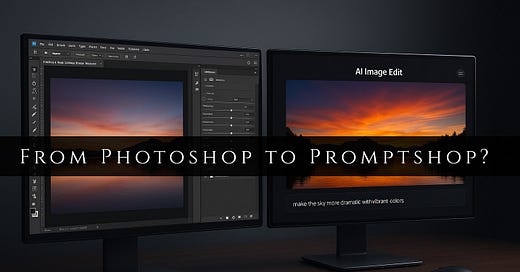From Photoshop to Promptshop? Imaging AI Tools Are Shifting the Editing Landscape
An editorial on why Adobe may face a Kodak moment if it doesn't move fast enough.
When new models like Flux Kontext (available on Leonardo AI) emerge, it’s easy to categorize them as experimental or interesting, but not yet ready for professional workflows. And in many ways, that's true… For now.
But Flux Kontext does something notably different from other AI tools. It edits. Not by drawing from text prompts alone, but by working directly from a reference image, adjusting colors, contours, and tone with a kind of visual intelligence that feels eerily like working with an assistant in a digital darkroom. It’s not just about prompts anymore. You bring an image to the table, tell it what to adjust, and it goes to work.
Which brings us to Adobe.
Adobe’s Position: Still Dominant, but for How Long?
No one questions Adobe’s dominance in the creative software industry. Photoshop and Lightroom remain the backbone of most professional editing workflows. With deep feature sets, robust precision tools, and widespread industry integration, Adobe’s tools are unlikely to be replaced in the short term.
But history doesn’t always reward the incumbent.
Lessons from Kodak and Xerox
Kodak invented the digital camera, but didn’t bet on it. Xerox helped pioneer the graphical user interface and mouse, but didn’t commercialize them. They let an upstart, Apple Computer, do it.
Both companies had a technological lead, and both lost it. They were deeply invested in what had already worked and underestimated what was coming next.
Adobe is clearly working to avoid that fate. Its rollout of Firefly, generative fill, and AI-powered features in Photoshop and Lightroom indicates it understands the stakes. However, the pace of innovation is no longer solely in Adobe’s hands.
A New Kind of Editing
Tools like Flux Kontext, ChatGPT, and others in development bypass traditional editing interfaces altogether. There are no layers, masks, or sliders. Instead, users can refine visual elements through text or visual reference, effectively "talking" to the image.
This may sound rudimentary to professionals, but it points toward a future where casual users and even some professionals may begin with a model like this instead of traditional software, especially when speed or imagination takes precedence over technical control.
We’ve seen a similar evolution in photography before: from fully manual exposure to auto modes, and now to computational photography. Each time, ease of use and powerful automation bring new audiences into the fold, and change expectations for what the “default” workflow looks like.
What’s at Stake for Adobe?
In our testing, Flux Kontext is not yet a complete replacement for Photoshop. But it offers something hard to ignore: a glimpse into the future with an alternate path to visual editing.
That’s what Adobe should be paying attention to… and likely is.
If these models continue to improve, and who doubts they will, Adobe may need to go beyond embedding AI in its current tools and start thinking about what an entirely new AI-native editing platform might look like. One that’s not just built for photographers, but for a generation that expects natural language, real-time interaction, and results that come from ideas rather than sliders. Topaz is well on the way to doing that with Topaz Photo AI.
This isn’t a prediction of Adobe’s downfall. But it’s a reminder: even industry leaders can miss the shift. And, big ships take a long time to turn around.
What’s at Stake for Photographers, Too
It’s easy to stick with what works. Most photographers have refined their workflows over years, sometimes decades, and it’s only natural to stay in familiar territory. It’s comfortable. But just as Adobe faces pressure to evolve, so do we.
We’re not suggesting anyone toss out Lightroom or abandon Photoshop. However, we believe it’s worth paying attention. AI tools from editing assistants to reference-driven transformers are reshaping what’s possible. Ignoring them doesn’t make the change go away. It just puts you a few steps behind when it finally becomes unavoidable.
We understand that AI in photography raises genuine questions about authenticity, originality, and even ethics. But history tells us that many of these concerns get addressed over time. What remains constant is the fact that new tools continually emerge and the creative field advances, whether we’re ready or not. The bigger opportunity lies for photographers who stay engaged now. They’ll be better positioned to take advantage of what’s to come.
That’s why we created this newsletter: to help photographers explore these tools without hype, without gimmicks, and without compromising photographic integrity.




